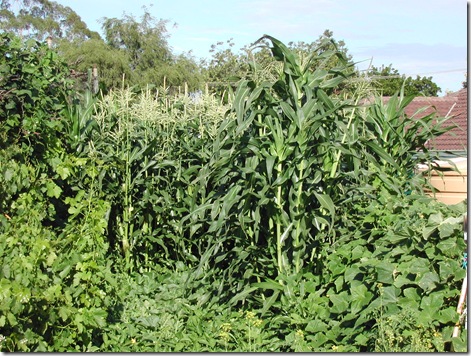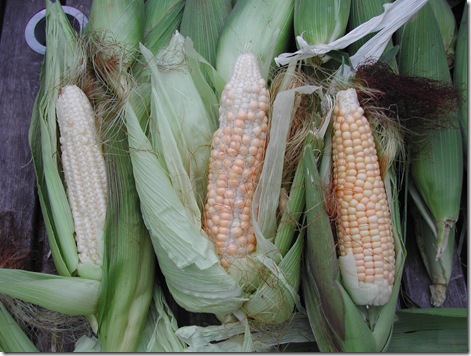One of the risks and pleasures of ‘seed saving’ for a kitchen gardener is that one does not always know the ‘provenance’ of the seed one sows, especially if has been handed over at a seed-swap meeting in an unmarked envelope! What will come up? Will it be worth keeping?
So it was this year with my ‘no-label’ sweet corn seed and those ‘long white-striped eggplants’ (more on these in a later article).
The sweet-corn grew to over 3m in height – I know this, because I’m nearly 2 metres tall and couldn’t touch the top without fetching a ladder!
Each stalk bore two to three cobs, and owed their lustrous growth to regular drip irrigation under a thick layer of barley-straw mulch over well-composted soil; corn and maize are ‘gross-feeders’, requiring and taking large amounts of nutrients from the soil. However, the returns are high for the right variety, as there is nothing quite like fresh-picked sweet-corn boiled gently in water, then spread with melting butter. (Sweet corn should be eaten as soon as possible after picking, as the sugars within it turn rapidly to starch, depleting the nutritional value of this vegetable within hours of harvest).
But first came that big wind storm that flattened half the crop, followed by rats travelling in from miles around to climb the stalks in the dark of the night, cutting through the outer husk with their long sharp incisor teeth then stripping the corn kernels from the cobs. To save something for humans and chooks meant harvesting the crop before it was completely ripe (including the half-chewed cobs for the chickens).
Sweet corn should be grown, not in rows, but in squares. The reason for this is that it is wind-pollinated, and the male flowers on top of the plants shower pollen on the female cobs below. Each small thread (called a ‘silk’) in the ‘tassel’ sticking out the top of the cob connects to a single kernel in the cob below, and each silk must receive a pollen spore. So incomplete pollination means ragged development of the cob, as in the central cob in the photo below. The whitish cob on the left is immature; the kernels have yet to ripen, making this one fit for chooks but not for humans. The cob on the right, however, would be delicious!



0 comments:
Post a Comment